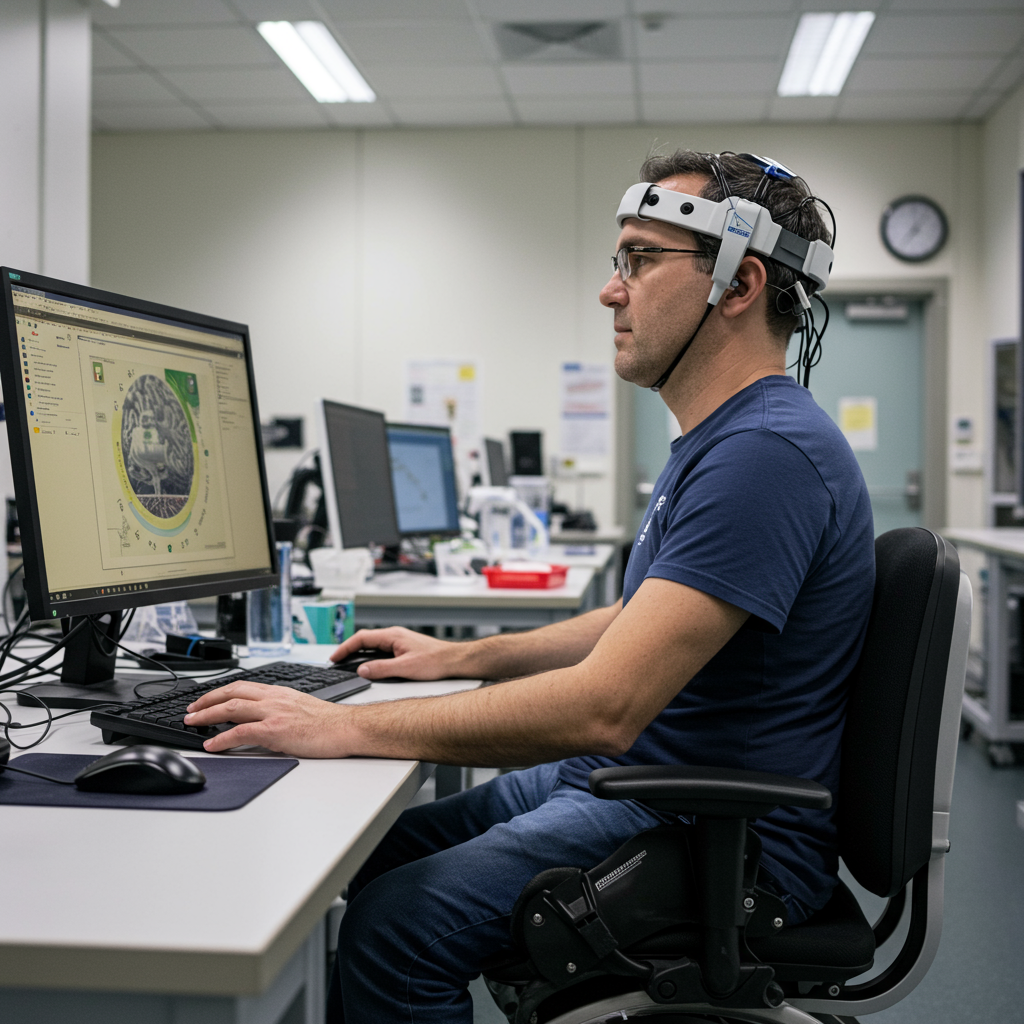For individuals living with severe disabilities, such as paralysis or amyotrophic lateral sclerosis (ALS), the simple act of communication or movement can be an insurmountable challenge. Exciting advancements in neurotechnology, specifically brain-computer interfaces (BCIs), are poised to change this reality dramatically. these cutting-edge systems create a direct link between a person’s thoughts and external devices, offering a revolutionary path to restoring lost function and enhancing independence. Researchers and companies are now pushing BCI technology from the lab toward widespread commercial availability, promising a future where clicking, speaking, and moving with the power of thought is possible.
What Are Brain-Computer Interfaces?
At its core, a brain-computer interface is a system that captures and translates neural activity into commands that can be understood by a computer or other device. For people unable to use their limbs or vocal cords, BCI offers a direct communication channel from the brain. These systems typically involve sensors that detect electrical signals from the brain, an interface that processes these complex patterns, and an external device (like a computer cursor, robotic arm, or synthetic voice) that executes the desired action.
The technology decodes signals from brain areas responsible for movement or speech intentions. When a person tries to move a hand or thinks of a word, specific neural patterns are generated. BCI systems learn to recognize these patterns. Recent advancements, particularly in artificial intelligence (AI), have significantly improved this decoding process, making it more accurate and reliable. AI algorithms can analyze vast amounts of neural data to identify subtle patterns that reveal a user’s specific intentions, whether it’s moving a cursor or articulating a complex sentence.
From Lab Curiosity to Commercial Promise
The concept of using thoughts to control external devices isn’t entirely new. Pioneering work demonstrated this possibility over two decades ago. In 2004, a team including Dr. Leigh Hochberg at Brown University and Massachusetts General Hospital linked the brain of Matt Nagle, who was paralyzed, to a computer using wires. Nagle successfully used his thoughts to move a cursor and even open email, a moment Hochberg described as containing “a little bit of magic.” This early research, which evolved into the BrainGate consortium, laid crucial groundwork.
Today, the technology is dramatically more sophisticated. Instead of monitoring a few dozen neurons, modern BCIs can listen to thousands. Wired connections are giving way to wireless communication. bulky computer setups are being replaced by connections to simple laptops or smartphones. Several companies are now leading the charge to bring this technology out of academic settings and into the commercial market. They believe the foundational technology is ready for prime time.
Key Players and Different Approaches in BCI
The BCI field is seeing intense activity, with several companies vying to be the first to offer commercial products. Elon Musk’s Neuralink is perhaps the most widely recognized name, largely due to its high-profile demonstrations. However, other significant players like Precision Neuroscience, Blackrock Neurotech, Paradromics, and Synchron also hold considerable promise.
These companies employ different technical strategies. Neuralink, for instance, involves surgically implanting a small, wireless device and threading over a thousand electrodes into the brain’s motor cortex. This approach allows for very detailed neural signal detection.
Other companies are exploring less invasive methods. Precision Neuroscience, co-founded by neurosurgeon Ben Rapoport and led by CEO Michael Mager, utilizes a very thin film designed to sit on the surface of the brain without penetrating the tissue. Mager highlights this as potentially safer and easier for FDA approval. Precision’s initial goal is a wireless device enabling control of smartphones and computers for daily tasks and potential employment opportunities.
Synchron takes a completely different route, avoiding skull surgery altogether. Their electrodes are delivered through blood vessels, similar to procedures for placing arterial stents. This endovascular approach is seen as significantly less invasive.
Each approach presents unique advantages and challenges, influencing potential safety profiles and regulatory pathways. The diversity of methods reflects the rapid innovation occurring across the neurotech landscape.
Restoring Communication and Movement
The most immediate applications for BCI technology target individuals who have lost voluntary muscle control or the ability to speak, often due to spinal cord injuries or conditions like ALS. Early commercial brain implants are expected to focus on restoring basic computer control or generating artificial speech.
Patients like Phillip McKenzie, paralyzed since 2012, are already using experimental BCI systems to interact with virtual environments simulating daily tasks. Noland Arbaugh, the first recipient of a Neuralink implant, famously demonstrated controlling a computer cursor with his thoughts in early 2024. While this specific implant experienced some electrode retraction issues, it showcased the potential of wireless, implanted BCI for motor control.
Beyond cursor control, significant progress is being made in restoring speech. In June 2025, a BrainGate 2 team at the University of California, Davis, reported enabling a man with ALS to speak through a computer using a BCI. The synthesized voice, reconstructed from old audio of the man, was able to articulate phrases like “I. Am. Good.” Although slightly halting, this marked a significant step toward natural communication. Researchers at Stanford University and UCSF, leveraging AI, have achieved even faster and more accurate speech decoding, translating brain activity into computer-generated voice or text at speeds up to 62 words per minute with high accuracy using large vocabularies.
Adding the Sense of Touch: Sensory Feedback
Beyond simply controlling external devices, advanced BCI research is exploring how to provide users with sensory feedback. This is crucial for performing complex, dexterous tasks. Jennifer Collinger, a professor at the University of Pittsburgh, emphasizes that fine motor control requires more than just visual feedback; a sense of touch is essential for natural interaction.
The University of Pittsburgh has been a leader in this area, working with companies like Blackrock Neurotech. Nathan Copeland, paralyzed in a car accident, is a notable participant in these studies. Copeland, who famously bumped fists with President Obama using a robotic arm, later participated in a 2021 study demonstrating how touch sensation improved his ability to grasp and manipulate objects with a prosthetic hand. He reported being able to feel contact and judge grip strength, highlighting the immense value of sensory feedback. While revolutionary, experts like Collinger anticipate that advanced features like sensory feedback will likely appear in later generations of commercial neurotech products.
Significant Hurdles Remain on the Path to Market
Despite the rapid advancements and enthusiastic outlook, significant technical and regulatory challenges must be overcome before BCI devices become widely available. One major hurdle is managing the sheer volume of data generated. Systems sampling thousands of electrodes thousands of times per second produce enormous data streams. Current wireless technology cannot easily transmit this volume, requiring sophisticated on-device processing or data compression methods.
Another substantial obstacle is the regulatory pathway. Gaining approval from the Food and Drug Administration (FDA) requires extensive and costly clinical trials. Industry estimates suggest this could run into the hundreds of millions of dollars. Companies need significant resources and expertise to navigate this complex process.
Beyond technical and financial challenges, the increasing integration of AI into brain implants raises critical ethical, privacy, and safety concerns. AI systems can be vulnerable to errors, malfunctions, or even hacking. There are profound questions about mental privacy, autonomy, and the potential for misuse of technology that can monitor or influence brain activity. Organizations like UNESCO are calling for global regulation and ethical frameworks to address these potential threats. Public opinion, according to surveys, shows widespread reservations about implantable chips, highlighting concerns about security, unwanted changes, and the need for rigorous testing standards. Balancing innovation with robust safeguards is paramount.
The Near Future of Brain Interfaces
Despite the hurdles, the consensus among experts and company leaders is that commercial brain-computer interfaces are not decades away. The transition from experimental technology to marketable product is anticipated potentially within the next two to three years.
Initial products will likely focus on core functionalities proven in lab settings, such as precise cursor control or clear synthetic speech generation for individuals with severe motor impairments or communication loss. As the technology matures and regulatory pathways are established, more advanced features like sensory feedback and potentially even non-invasive applications (like decoding imagined speech without surgery) may become available.
The potential impact of these neural implants is immense. For people with paralysis or ALS, regaining the ability to interact directly with computers, communicate with loved ones, or even return to work could dramatically enhance quality of life and independence. While the journey involves significant challenges, the rapid pace of innovation suggests a future where thought can directly bridge the gap created by disability.
Frequently Asked Questions
How can brain-computer interfaces (BCIs) help people with disabilities?
Brain-computer interfaces offer a new way for people who have lost the ability to move or speak to interact with the world. By decoding their brain signals, BCIs can allow individuals with paralysis or ALS to control computer cursors, operate smartphones, use robotic prosthetics, or generate artificial speech simply by thinking about the action or word they want to perform. This technology aims to restore communication, mobility, and independence.
What are some leading companies developing brain implants and BCIs?
Several companies are at the forefront of developing commercial brain-computer interfaces. Key players mentioned include Neuralink, Precision Neuroscience, Blackrock Neurotech, Paradromics, and Synchron. These companies are pursuing different technological approaches, such as implanting electrodes directly into the brain, placing thin films on the brain’s surface, or delivering electrodes through blood vessels, each with potential implications for safety and regulatory approval.
What challenges remain before brain implants are widely available?
Despite rapid progress, several significant challenges must be addressed for brain implants to become widely available. These include managing and transmitting the enormous volume of data collected from thousands of electrodes, the high cost (potentially hundreds of millions of dollars) of conducting FDA-required clinical trials, and navigating complex ethical considerations surrounding mental privacy, data security, and the potential for misuse of neurotechnology.




